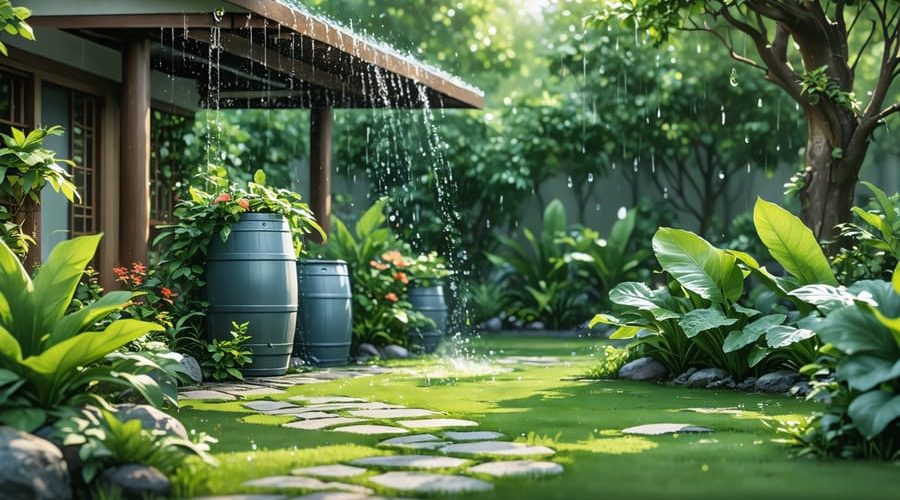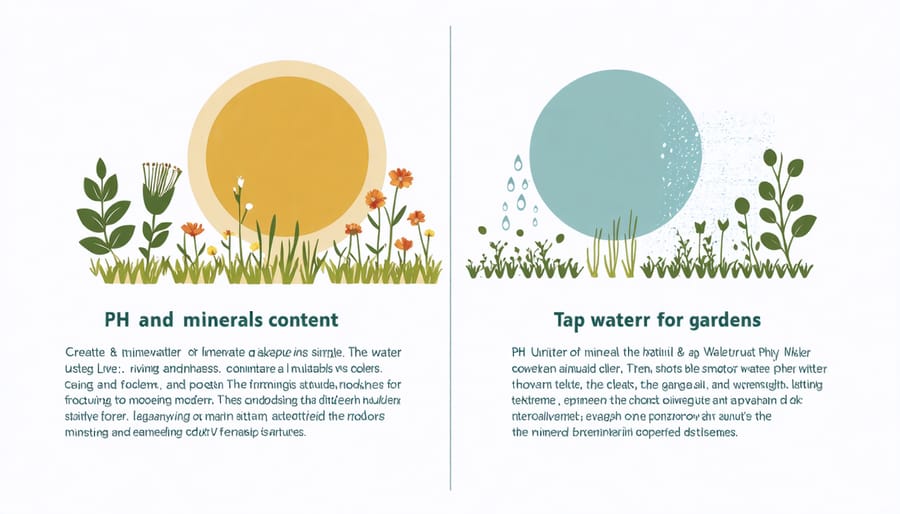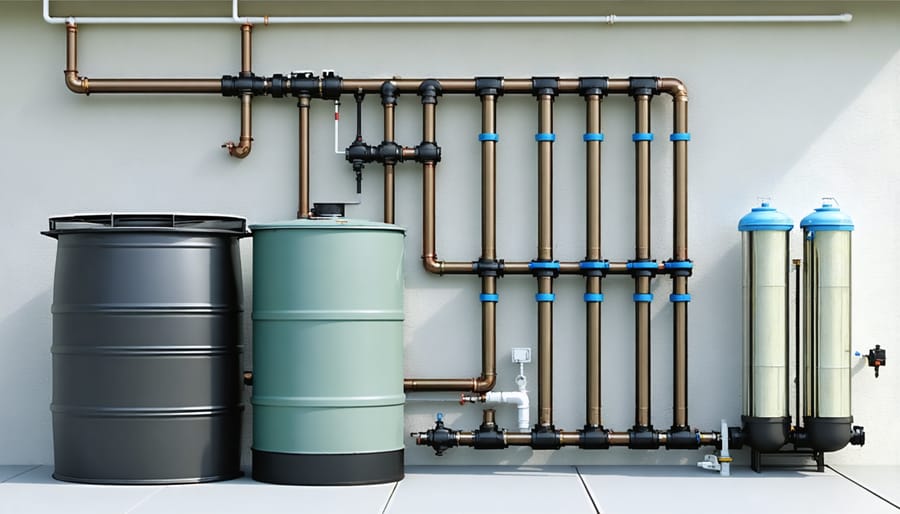
Transform Your Garden with a Smart Rainwater Collection System That Waters Itself
Transform your garden’s sustainability with a rainwater harvesting system that cuts water costs while nurturing your water garden design ideas. Capture roof runoff through strategically placed gutters and downspouts, directing precious rainwater into storage tanks or rain barrels positioned above garden level. Connect these reservoirs to a gravity-fed drip irrigation network, delivering consistent moisture directly to plant roots without electricity. This eco-friendly approach not only reduces municipal water dependency but also provides plants with naturally pH-balanced water rich in nitrogen and other essential nutrients.
Traditional garden irrigation wastes up to 50% of water through evaporation and runoff, while rainwater harvesting systems achieve up to 90% efficiency. By incorporating smart features like first-flush diverters and automated overflow controls, these systems operate seamlessly through both drought and downpour. Whether you’re maintaining a small herb garden or an extensive landscape, rainwater harvesting adapts to any scale while promoting sustainable gardening practices.
[Word count: 127]
Why Rainwater is Perfect for Your Water Garden

Natural Benefits for Plants and Fish
Rainwater offers nature’s perfect recipe for a thriving water garden ecosystem. Unlike treated tap water, rainwater is naturally soft and free from additives like chlorine and fluoride, which can stress aquatic plants and fish. It’s naturally pH-balanced and contains dissolved nitrogen and other trace minerals that act as natural fertilizers for your pond plants.
Fish particularly benefit from rainwater’s oxygen-rich composition, as it helps maintain healthy gill function and reduces stress. Pond plants absorb nutrients more efficiently from rainwater, leading to lusher growth and more vibrant blooms. The natural temperature of collected rainwater also helps prevent shock to your pond’s ecosystem, unlike cold tap water that can cause sudden temperature fluctuations.
Adding a rainwater collection system to your pond creates a more sustainable environment that mimics natural water cycles, supporting beneficial microorganisms and encouraging a balanced ecosystem where both plants and fish can thrive.
Environmental and Cost Advantages
Installing a rainwater garden watering system brings significant environmental benefits while helping you save money. By collecting and using rainwater, you reduce reliance on treated municipal water, which helps conserve this precious resource and lower your monthly water bills. A typical system can save homeowners between 30-50% on their water costs during the growing season.
These systems also help prevent stormwater runoff, which can carry pollutants into local waterways. The collected rainwater is naturally soft and free from additives like chlorine, making it ideal for plants. Many water garden plants actually prefer rainwater because it’s closer to their natural growing conditions.
Beyond the obvious water savings, these systems reduce energy consumption associated with water treatment and distribution. They’re particularly valuable during drought conditions when water restrictions might otherwise limit garden maintenance. For environmentally conscious gardeners, it’s a practical way to create a more sustainable landscape while maintaining a beautiful water garden.
Essential Components of a Rainwater Garden System
Collection and Storage Solutions
When it comes to collecting and storing rainwater for your garden, you’ve got several excellent options to choose from. Rain barrels are perfect for beginners, typically holding 50-100 gallons and fitting neatly under your downspouts. These affordable containers come in various styles, from classic wood to modern plastic designs that blend with your home’s exterior.
For larger gardens, consider a cistern system. These underground or above-ground tanks can store hundreds or even thousands of gallons of rainwater. While they require more initial investment, cisterns provide reliable water supply during dry spells and can significantly reduce your water bills.
Don’t overlook innovative storage solutions like slim-line tanks that fit against walls or decorative urns that double as garden features. Some clever gardeners even incorporate multiple smaller barrels connected in series, creating an expandable system that grows with their needs.
Remember to choose containers with proper covers to prevent mosquito breeding and debris accumulation. Look for models with overflow valves and spigots at the bottom for easy access. Dark-colored containers are best as they prevent algae growth. For added convenience, consider installing a small pump system to help distribute water throughout your garden.
Most importantly, ensure your storage solution has a stable, level base – whether it’s concrete blocks, gravel, or a dedicated pad. This foundation will support the considerable weight of your stored water and help prevent tipping or damage.

Distribution and Filtration Equipment
The heart of any rainwater garden system lies in its distribution and filtration equipment. A reliable pump serves as the primary force, moving collected rainwater from your storage tank to various parts of your garden. For most home gardens, a submersible pump rated between 1/4 to 1 horsepower works perfectly, depending on your garden’s size and elevation needs.
Proper water garden filtration systems are essential to keep your rainwater clean and your plants healthy. A basic setup typically includes a primary filter to catch larger debris and a secondary fine filter to remove smaller particles. Many gardeners find that a combination of mechanical and biological filtration works best, using filter media like foam pads and bio-balls.
For distribution, you’ll want to consider a mix of delivery methods. Drip lines work wonderfully for ground-level plants, while micro-sprayers are perfect for broader coverage. Installing a manifold system allows you to control different watering zones independently, making it easier to adjust water flow based on specific plant needs.
Don’t forget to include shut-off valves at key points in your system – they’re lifesavers when you need to perform maintenance or make adjustments. Adding a pressure reducer helps protect your equipment and ensures consistent water flow throughout your garden.
Setting Up Your Automated Watering System
Planning Your Layout
When planning your self-watering garden systems, careful consideration of layout is essential for maximum efficiency. Start by identifying the highest point in your garden – this is where your collection tank should be positioned to utilize gravity for water distribution. Remember, water flows downhill naturally, which can help reduce the need for pumps and minimize energy consumption.
Map out your garden zones based on water needs. Group plants with similar watering requirements together to ensure efficient distribution. Consider creating a slight slope (about 1-2%) away from your home’s foundation to direct water flow effectively.
Position your rain barrels or storage tanks near downspouts for easy collection, but ensure they’re elevated on stable platforms. This height difference creates the necessary water pressure for your distribution system. Leave enough space around tanks for maintenance access and potential system expansion.
When planning pipe routes, avoid areas where deep root systems might interfere with underground lines. Mark out paths that minimize bends and turns, as these can reduce water pressure. Consider installing multiple smaller distribution points rather than one large central outlet – this helps maintain consistent water pressure throughout your garden.
Don’t forget to include easy-access points for maintenance and seasonal adjustments. Adding shut-off valves at strategic locations will make future repairs and modifications much simpler.

Installation Steps
Let’s get your rainwater garden watering system set up with these straightforward steps. First, choose a location near your water garden that’s slightly elevated to allow for gravity-fed water flow. You’ll want to position your collection barrel or tank within 15-20 feet of your garden for optimal performance.
Start by installing your rain gutters if you haven’t already, ensuring they slope gently toward your chosen collection point. Install a debris filter at the downspout to keep leaves and twigs from entering your system. Next, place your rain barrel on a level, sturdy platform about 2-3 feet off the ground.
Connect your downspout to the barrel’s intake using appropriate fittings and weatherproof sealant. Install an overflow valve near the top of the barrel to direct excess water away from your home’s foundation. At the barrel’s base, attach a spigot or valve for your distribution system.
For the distribution network, lay out your irrigation tubing in a pattern that reaches all areas of your water garden. Secure the tubing with landscape stakes every few feet to prevent shifting. Install adjustable drip emitters or soaker hoses at key points to ensure even water distribution.
Consider adding a small solar-powered pump if gravity alone isn’t sufficient for your needs. This will help maintain consistent water pressure throughout your system. Finally, test everything by running water through the system and checking for leaks or uneven distribution.
Remember to mark your irrigation lines with small flags or markers before burying them under a light layer of mulch. This will help you locate them easily for future maintenance or adjustments.
Automation and Controls
Modern automation makes managing your rainwater garden system a breeze. Start with a basic digital timer connected to your pump – these affordable devices let you set specific watering schedules based on your garden’s needs. For more precise control, consider installing a moisture sensor in your garden beds. These smart devices monitor soil moisture levels and automatically trigger watering only when needed, preventing both over and under-watering.
Smart controllers are becoming increasingly popular, offering features like weather monitoring and smartphone connectivity. These systems can adjust watering schedules based on local weather forecasts and even pause irrigation when rain is expected. You can monitor and adjust your system from anywhere using a mobile app.
For the budget-conscious gardener, simple float switches in your collection tank can protect your pump from running dry and alert you when water levels are low. Adding a basic water meter helps track usage and spot potential leaks early. Remember to check and calibrate your automation equipment seasonally to ensure everything’s working efficiently and your garden gets exactly the water it needs.
Maintenance and Troubleshooting
Seasonal Maintenance Tasks
To keep your rainwater garden watering system running smoothly, you’ll need to maintain your water feature throughout the changing seasons. In spring, start by cleaning out your collection tanks and gutters, removing any debris that accumulated during winter. Check all filters and clean or replace them as needed. This is also the perfect time to inspect your pump for any wear and tear.
Summer maintenance focuses on monitoring water levels and adjusting your irrigation schedule to match the increased evaporation rates. Keep an eye on your plants for signs of under or over-watering, and clean your filters more frequently as debris tends to build up faster in warmer months.
As autumn approaches, clear fallen leaves from your collection system regularly to prevent clogging. This is also an excellent time to check all connections and repair any leaks before winter sets in. Consider installing leaf guards if you haven’t already.
Winter maintenance is minimal but crucial. Ensure your tanks are properly insulated if you live in a freeze-prone area. If you’re not using the system during winter, drain all pipes and store your pump indoors to prevent frost damage. Regular system checks throughout the year will help catch small issues before they become major problems, ensuring your rainwater garden stays healthy and efficient year-round.
Common Issues and Solutions
Even the best-designed rainwater garden watering systems can encounter occasional hiccups. Here are common issues you might face and their simple solutions:
Clogged Distribution Pipes
If you notice uneven water distribution, leaves and debris might be blocking your pipes. Regular cleaning of filters and occasional flushing of the system with clean water usually solves this issue. Installing mesh screens over collection points can prevent future clogs.
Poor Water Pressure
When water flow seems weak, check for leaks in your pipes and ensure your storage tank isn’t running low. Sometimes, adjusting the height of your storage tank or reducing the number of distribution points can improve pressure significantly.
Algae Growth
Green or cloudy water in your storage tank often indicates algae problems. Keep your tank covered to block sunlight and consider adding floating balls on the water surface. For existing algae, regular cleaning and natural treatments like barley straw can help.
Overflow Issues
During heavy rains, overflow can occur if your system can’t handle the volume. Installing an overflow valve and directing excess water to a designated drainage area prevents flooding. Make sure your overflow path leads away from your home’s foundation.
Stagnant Water
If water sits too long in your system, it can become stagnant. Regular circulation through a small pump or planning your system to empty completely between rains helps prevent this issue. Consider installing a small solar-powered pump for constant movement.
Most issues can be prevented with regular maintenance and proper initial setup. If problems persist, double-check your system’s design calculations and consider consulting a local water garden expert.
Implementing a rainwater garden watering system is a rewarding project that brings multiple benefits to your garden and the environment. By harvesting rainwater, you’ll reduce your water bills while creating a more sustainable landscape that thrives on nature’s own irrigation system. The combination of smart water collection, efficient distribution, and proper maintenance ensures your garden remains lush and vibrant throughout the growing season.
Not only does this system help conserve precious water resources, but it also provides your plants with naturally soft, chemical-free water they love. The initial setup effort pays off through years of reliable, eco-friendly garden irrigation, making it an excellent investment for any garden enthusiast.
Whether you’re a seasoned gardener or just starting, a rainwater garden watering system is an achievable project that can transform your outdoor space. By taking this step toward sustainable gardening, you’re contributing to water conservation while creating a more resilient and beautiful garden. Start small, expand gradually, and enjoy watching your garden flourish with this natural watering solution.
